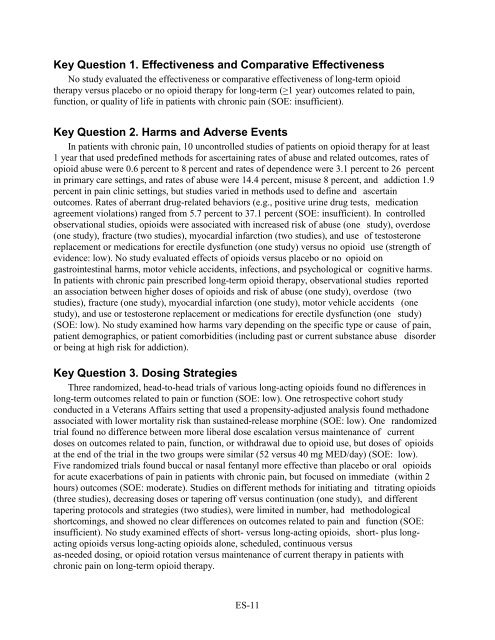chronic-pain-opioid-treatment-report-140929
chronic-pain-opioid-treatment-report-140929
chronic-pain-opioid-treatment-report-140929
Create successful ePaper yourself
Turn your PDF publications into a flip-book with our unique Google optimized e-Paper software.
Key Question 1. Effectiveness and Comparative EffectivenessNo study evaluated the effectiveness or comparative effectiveness of long-term <strong>opioid</strong>therapy versus placebo or no <strong>opioid</strong> therapy for long-term (>1 year) outcomes related to <strong>pain</strong>,function, or quality of life in patients with <strong>chronic</strong> <strong>pain</strong> (SOE: insufficient).Key Question 2. Harms and Adverse EventsIn patients with <strong>chronic</strong> <strong>pain</strong>, 10 uncontrolled studies of patients on <strong>opioid</strong> therapy for at least1 year that used predefined methods for ascertaining rates of abuse and related outcomes, rates of<strong>opioid</strong> abuse were 0.6 percent to 8 percent and rates of dependence were 3.1 percent to 26 percentin primary care settings, and rates of abuse were 14.4 percent, misuse 8 percent, and addiction 1.9percent in <strong>pain</strong> clinic settings, but studies varied in methods used to define and ascertainoutcomes. Rates of aberrant drug-related behaviors (e.g., positive urine drug tests, medicationagreement violations) ranged from 5.7 percent to 37.1 percent (SOE: insufficient). In controlledobservational studies, <strong>opioid</strong>s were associated with increased risk of abuse (one study), overdose(one study), fracture (two studies), myocardial infarction (two studies), and use of testosteronereplacement or medications for erectile dysfunction (one study) versus no <strong>opioid</strong> use (strength ofevidence: low). No study evaluated effects of <strong>opioid</strong>s versus placebo or no <strong>opioid</strong> ongastrointestinal harms, motor vehicle accidents, infections, and psychological or cognitive harms.In patients with <strong>chronic</strong> <strong>pain</strong> prescribed long-term <strong>opioid</strong> therapy, observational studies <strong>report</strong>edan association between higher doses of <strong>opioid</strong>s and risk of abuse (one study), overdose (twostudies), fracture (one study), myocardial infarction (one study), motor vehicle accidents (onestudy), and use or testosterone replacement or medications for erectile dysfunction (one study)(SOE: low). No study examined how harms vary depending on the specific type or cause of <strong>pain</strong>,patient demographics, or patient comorbidities (including past or current substance abuse disorderor being at high risk for addiction).Key Question 3. Dosing StrategiesThree randomized, head-to-head trials of various long-acting <strong>opioid</strong>s found no differences inlong-term outcomes related to <strong>pain</strong> or function (SOE: low). One retrospective cohort studyconducted in a Veterans Affairs setting that used a propensity-adjusted analysis found methadoneassociated with lower mortality risk than sustained-release morphine (SOE: low). One randomizedtrial found no difference between more liberal dose escalation versus maintenance of currentdoses on outcomes related to <strong>pain</strong>, function, or withdrawal due to <strong>opioid</strong> use, but doses of <strong>opioid</strong>sat the end of the trial in the two groups were similar (52 versus 40 mg MED/day) (SOE: low).Five randomized trials found buccal or nasal fentanyl more effective than placebo or oral <strong>opioid</strong>sfor acute exacerbations of <strong>pain</strong> in patients with <strong>chronic</strong> <strong>pain</strong>, but focused on immediate (within 2hours) outcomes (SOE: moderate). Studies on different methods for initiating and titrating <strong>opioid</strong>s(three studies), decreasing doses or tapering off versus continuation (one study), and differenttapering protocols and strategies (two studies), were limited in number, had methodologicalshortcomings, and showed no clear differences on outcomes related to <strong>pain</strong> and function (SOE:insufficient). No study examined effects of short- versus long-acting <strong>opioid</strong>s, short- plus longacting<strong>opioid</strong>s versus long-acting <strong>opioid</strong>s alone, scheduled, continuous versusas-needed dosing, or <strong>opioid</strong> rotation versus maintenance of current therapy in patients with<strong>chronic</strong> <strong>pain</strong> on long-term <strong>opioid</strong> therapy.ES-11


